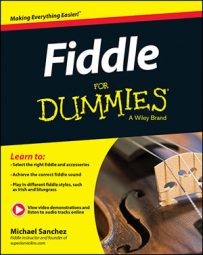Understanding finger numbers
For finger numbering, each one of your fingers on the left hand, except for your thumb, represents a number. No fingers down on the fingerboard (a position known as open) also represents a number. The numbering goes as follows:No fingers: This is considered value 0, or open.
The index finger: This is considered your first finger, or value 1.
The middle finger: This is considered your second finger, or value 2.
The ring finger: This is considered your third finger, or value 3.
The pinkie: This is considered your fourth finger, or value 4.
You need to know exactly what finger is your first finger, your second finger, and so on without even having to think about it. This will go a long way toward helping you to read music.
Fingering progression
For the first couple of weeks, it’s important that you master nothing else but notes on the D and A strings — the middle two strings. Before you learn to read music, it’s important to understand each of the notes on these two strings using what’s called finger notation. Finger notation shows which finger to put down on the fiddle by the string and finger being used.For now, the second finger notes are sharp notes (designated by ♯), which basically means they’re a higher pitch than the standard letter note. The higher-pitched second finger notes work well in learning basic songs.
Don’t worry about the pinkie finger for now.
Listen to Chapter 6, Audio Track 5 to hear what the basic note pitches on the fiddle should sound like.
| Note | Finger Placement | Pitch |
|---|---|---|
| D0 | No fingers down on the D string | D |
| D1 | First finger down on the D string | E |
| D2 | Second finger down on the D string | F♯ |
| D3 | Third finger down on the D string | G |
| A0 | No fingers down on the A string | A |
| A1 | First finger down on the A string | B |
| A2 | Second finger down on the A string | C♯ |
| A3 | Third finger down on the A string | D |
![[Credit: By Rashell Smith]](https://www.dummies.com/wp-content/uploads/458897.image0.jpg)
When you’re done with note D3, the next note you play in the progression is A0. This change from one note to the next means you have to cross over to the next higher string to play the next note in the progression. When you start using the bow, this switch from one note to the next is called a bow crossover.
Putting on stickers
Before you actually start making contact with the fingerboard to make different notes, you need to put down a set of stickers so you know exactly where your fingers will be going. Don’t rush through this process; the closer the stickers are to the correct spots, the more in tune you’ll be.-
Get a set of round stickers or finger tape.
Either of these can represent where to put fingers down on the fiddle.
-
Tune the D string as precisely as possible.
-
Take your 1stfinger and put pressure down on the D string in the same spot vertically as your thumb sticker.
-
Pick the string with your finger to get a sound.
-
Adjust the finger until your tuner reads “E.”
Try to get as close as you can to exact pitch.
-
Keep your finger in the perfect “E” spot and peel your sticker with the other hand.
-
Now for the tricky part: Slide the sticker as close as you can to the spot where your finger is.
-
Check again to make sure your D is in tune.
-
Put your finger directly over where you placed the sticker and match perfect “E” on the tuner.
-
If your finger is covering the sticker perfectly, you’re done with that note.
If you find that you aren’t quite in the right spot, adjust the sticker accordingly.
-
Do the same thing with F♯ and G.
Remember that the tuner should read “F♯” — not just “F” — for you to place the sticker properly.
Although you won’t be working with the 4th finger for a while, you can still place the sticker on the fingerboard where it should go. On the D string, your 4th finger will be an A pitch. You can follow the preceding steps to place the 4th finger sticker, which will be about the same distance as your 1st finger is from your 2nd finger.
Don’t feel like you’re cheating by using stickers. Because the fiddle is fretless, you need to know exactly where to place your fingers to sound your best. The stickers shouldn’t be on your fiddle forever, but give yourself a timeline of about 6 to 12 months before you take off the stickers.
Now that you have your stickers in the right spot, it’s important to note what they represent. Because all the first finger notes across the fiddle are parallel to one another, you don’t need to put stickers on every string. Using the finger tape does represent this clearer than the round stickers, but either one works.Check to see how your first finger sticker lines up with your thumb sticker. The first finger and thumb should be parallel. If they’re off slightly, adjust your thumb sticker.

